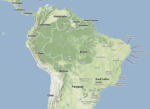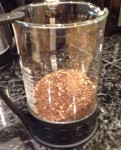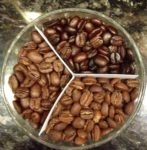Why We Care About Roast Level: An Example
Short Answer: Coffee flavors differ according to roast level, even in the same bean. To illustrate, we used a high-quality, very versatile Colombian coffee, roasted it four ways and described the flavors.
The Difference Roast Level Makes – Colombia Huila Region
 Where this coffee originated: Southern Andes, Colombia, South America, elevation about 2200 MASL
Where this coffee originated: Southern Andes, Colombia, South America, elevation about 2200 MASL
For this demonstration, we chose a Colombia Huila, from Southern Colombia high in the Andes. The altitude really shows in the density of the beans and how well it holds up to extended heat. We roasted 4 batches, ranging from City+ to Light French/Vienna Roast. Even after two hours, fragrance developed nicely in the darker roasts, less so in the medium roasts. We let all the batches rest for 24 hours and then cupped them together. Here’s the short form of the tasting, more as a qualitative comparison focusing on how roast level changes taste, not a strict SCAA quality cupping routine (though others rated it between 87-89 out of 100, meaning really really excellent coffee).
City + Roast (lightest of the four) – Clean cup, medium body, buttery mouth feel, full of nutty roundness, molasses and caramel praline. There is a nice balanced acidity that makes it lively but not over the top. This is one sweet cup! I tried this as a pour-over and as drip. I suspect it would make a great espresso shot, too.
Full City Roast (Medium roast) – Flavors becoming more distinctive, darker caramel rising and sweetness is starting to give way a bit to semisweet chocolaty notes. If there were hints of fruit in the lighter roast, they were gone in this batch. This level begins to feel spicier, like Mexican chocolate.
Full City+ Roast (darker medium roast, with a few drops of oil making their way to the bean surface) – Sweetness and body are lessening in favor of darkening caramel and burnt sugar, with semisweet chocolate becoming more pronounced. At this level, brightness is diminishing somewhat, too. My drip sample of this roast was less satisfying than the two lighter roasts (probably personal preference at work here), but the french press pot at this level regained the body and some muted brightness that was absent in the drip. I didn’t try espresso, but I would guess that this is the roast point where single origin espresso would begin to shine.
French/Vienna Roast (Dark, with oil on the beans) – I roasted this batch to French roast by request for espresso, and we hit a home run with it after resting it a total of 72 hours. Though the body was less heavy (especially compared to the lighter roasts), the espresso had a buttery mouth feel that was quite satisfying, with a very nice crema. Molasses sweetness and any hint of fruit is gone. Pleasantly bittersweet chocolate and spicy dark, dark caramel toffee flavors are most pronounced. This coffee remains amazingly clean and smooth even at a dark roast, with roasty goodness, burnt sugar and bittering hints well under control.
Just for grins, I made a french press pot of the French Roast and a drip pot of the City+ Roast to serve at a meeting of about a dozen folks with a range of coffee preferences. I didn’t tell them it was the same bean. The group seemed to split along partisan lines (no, not those partisans) between those who enjoyed the buttery caramel/nuttiness of the light roast and those who liked the assertive flavors of the dark roast. Nobody believed me when I said it was the same coffee roasted two different ways. Of course, it was April 1…
And this adds further evidence that roast level DOES matter, but it matters according to what you like.
enjoy your coffee!
s



